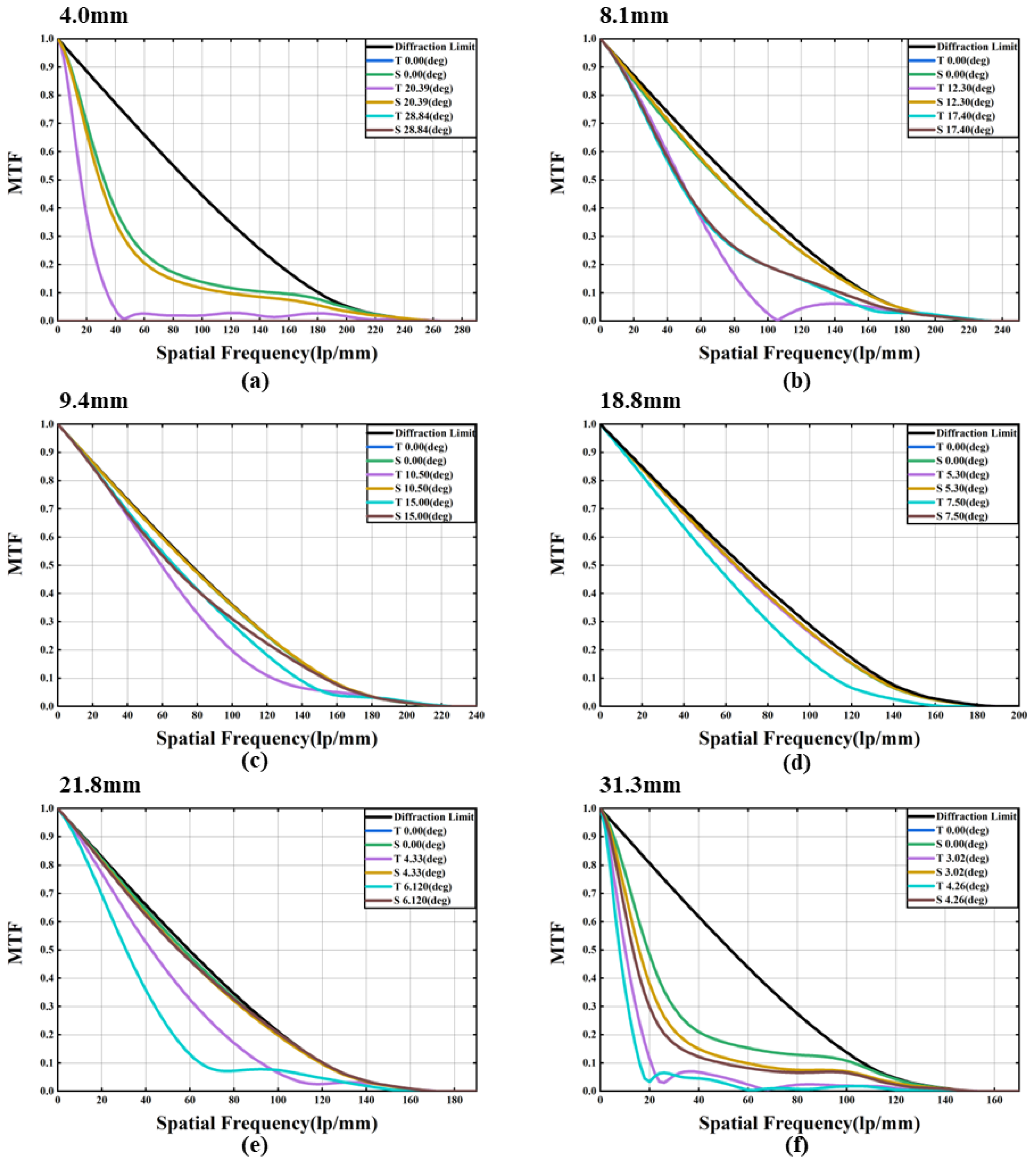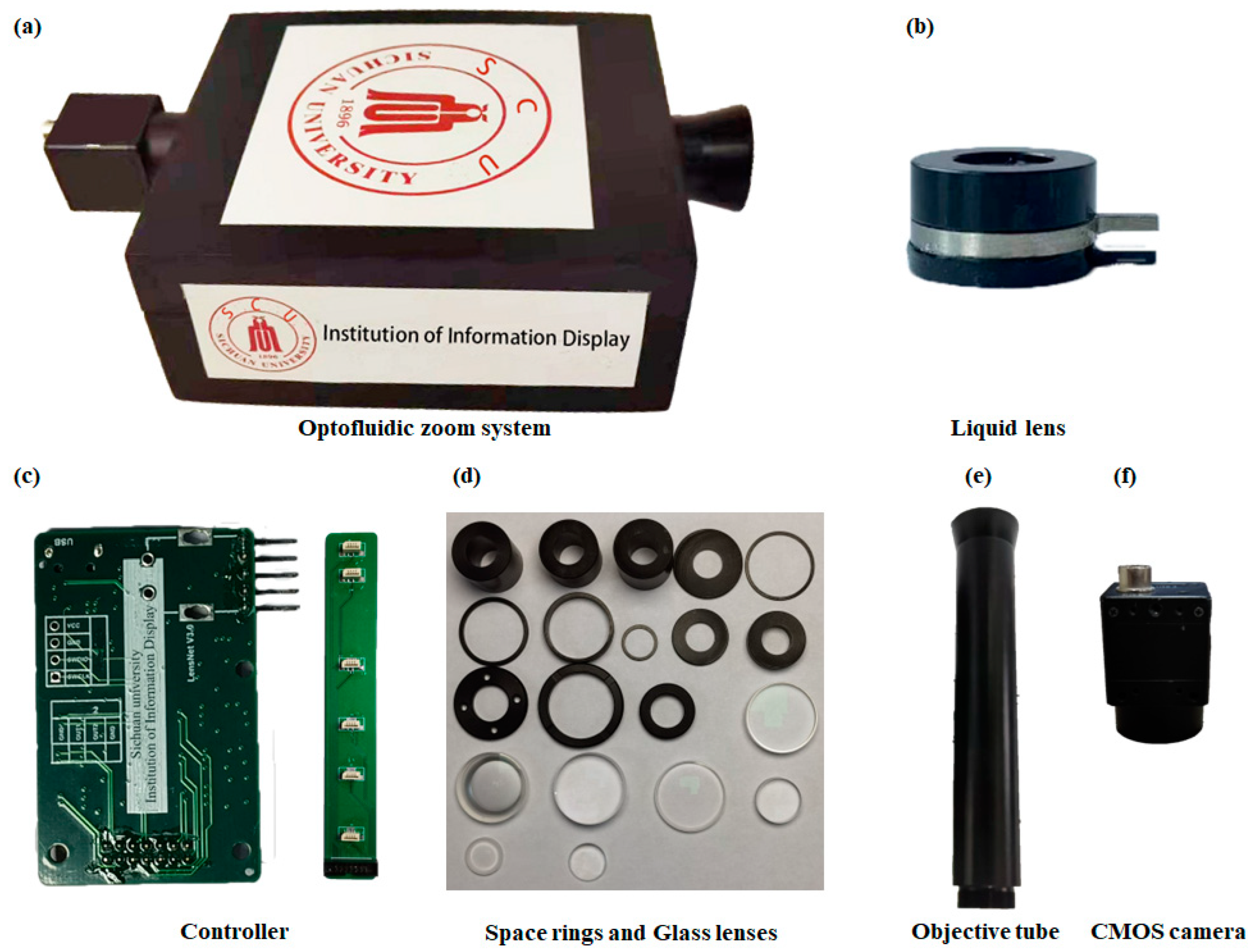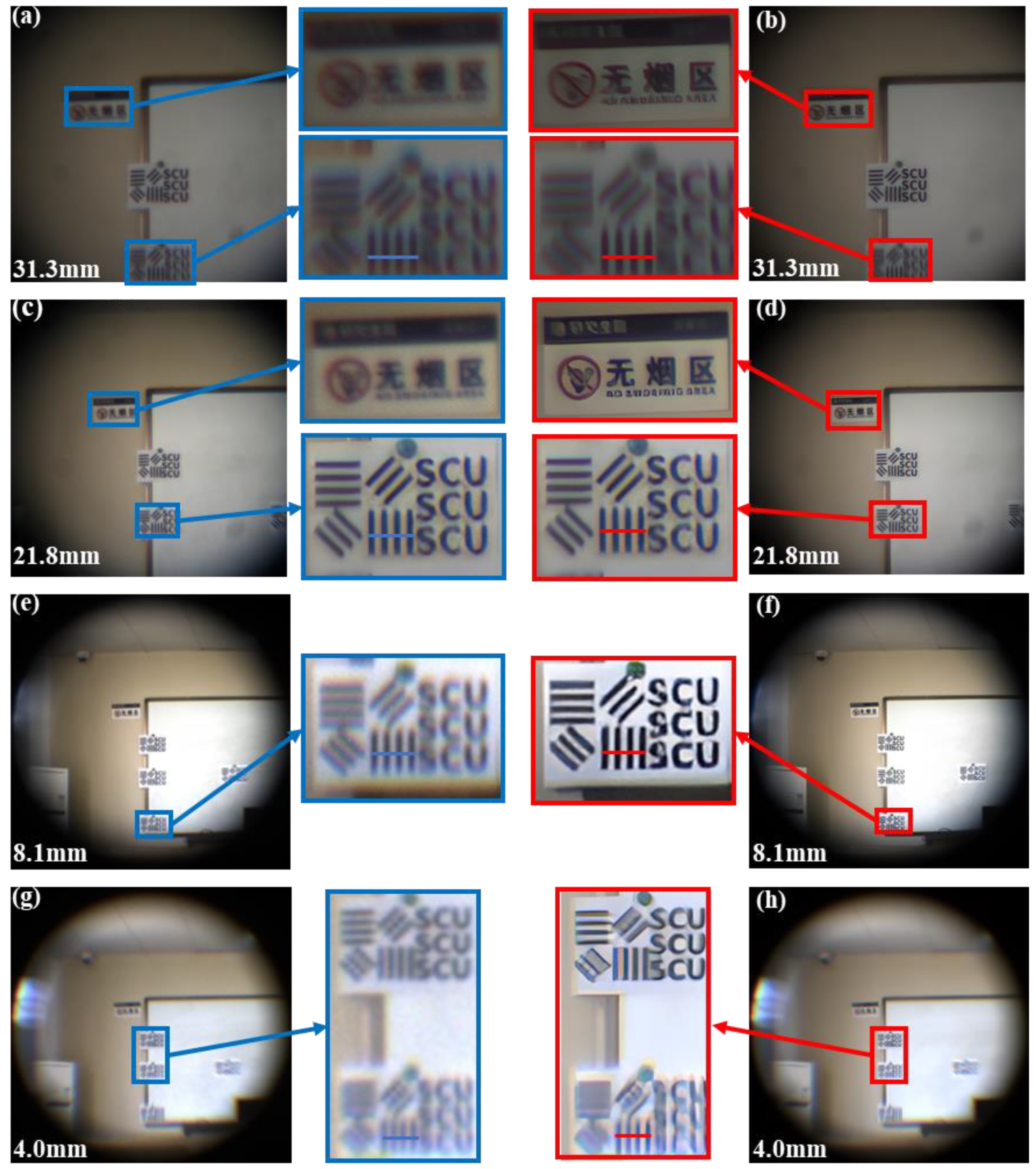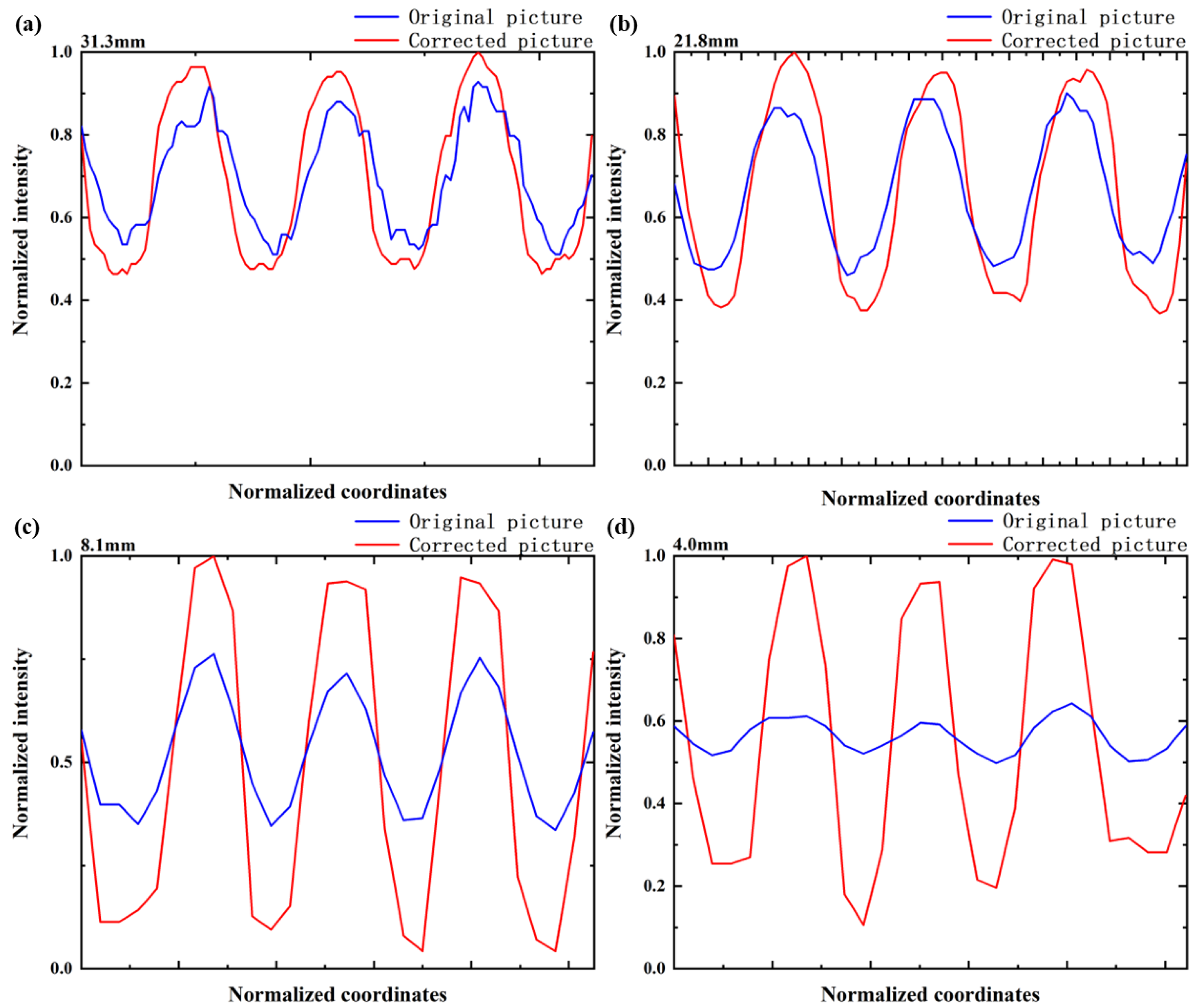Deep Learning Enables Optofluidic Zoom System with Large Zoom Ratio and High Imaging Resolution
Abstract
1. Introduction
2. System Structure
2.1. Optofluidic Zoom Objective
2.2. Image Processing Module
3. Design and Fabrication
4. Experiment
5. Conclusions
Author Contributions
Funding
Institutional Review Board Statement
Informed Consent Statement
Data Availability Statement
Conflicts of Interest
References
- Akram, M.N.; Asghar, M.H. Step-zoom dual-field-of-view infrared telescope. Appl. Opt. 2003, 42, 2312–2316. [Google Scholar] [CrossRef]
- Park, S.-C.; Lee, S.-H.; Kim, J.-G. Compact Zoom Lens Design for a 5x Mobile Camera Using Prism. J. Opt. Soc. Korea 2009, 13, 206–212. [Google Scholar] [CrossRef]
- Ok, C.-M.; Park, S.-C. Design and Analysis of a 10× Optical Zoom System for an LWIR Camera. J. Opt. Soc. Korea 2014, 18, 574–581. [Google Scholar] [CrossRef]
- Fan, C.; Yang, B.; Liu, Y.; Gu, P.; Wang, X.; Zong, H. Zoom lens with high zoom ratio design based on Gaussian bracket and particle swarm optimization. Appl. Opt. 2021, 60, 3217–3223. [Google Scholar] [CrossRef]
- Qu, R.; Duan, J.; Liu, K.; Cao, J.Z.; Yang, J.F. Optical Design of a 4x Zoom Lens with a Stable External Entrance Pupil and Internal Stop. Photonics 2022, 9, 10. [Google Scholar] [CrossRef]
- Zhang, K.; Qu, Z.; Zhong, X.; Li, F.; Yu, S. 40× zoom optical system design based on stable imaging principle of four groups. Appl. Opt. 2022, 61, 1516–1522. [Google Scholar] [CrossRef]
- Zhang, W.; Li, D.; Guo, X. Optical Design and Optimization of a Micro Zoom System with Liquid Lenses. J. Opt. Soc. Korea 2013, 17, 447–453. [Google Scholar] [CrossRef]
- Li, L.; Wang, D.; Liu, C.; Wang, Q.-H. Ultrathin zoom telescopic objective. Opt. Express 2016, 24, 18674–18684. [Google Scholar] [CrossRef] [PubMed]
- Li, L.; Wang, D.; Liu, C.; Wang, Q.-H. Zoom microscope objective using electrowetting lenses. Opt. Express 2016, 24, 2931–2940. [Google Scholar] [CrossRef]
- Kopp, D.; Brender, T.; Zappe, H. All-liquid dual-lens optofluidic zoom system. Appl. Opt. 2017, 56, 3758–3763. [Google Scholar] [CrossRef] [PubMed]
- Li, L.; Yuan, R.-Y.; Wang, J.-H.; Wang, Q.-H. Electrically optofluidic zoom system with a large zoom range and high-resolution image. Opt. Express 2017, 25, 22280–22291. [Google Scholar] [CrossRef]
- Park, I.S.; Park, Y.; Oh, S.H.; Yang, J.W.; Chung, S.K. Multifunctional liquid lens for variable focus and zoom. Sens. Actuators A Phys. 2018, 273, 317–323. [Google Scholar] [CrossRef]
- Kuang, F.-L.; Yuan, R.-Y.; Wang, Q.-H.; Li, L. Large zooming range adaptive microscope employing tunable objective and eyepiece. Sci. Rep. 2020, 10, 14644. [Google Scholar] [CrossRef] [PubMed]
- Katz, J.I.; Lee, S.-y.; Hua, H. Improved multi-resolution foveated laparoscope with real-time digital transverse chromatic correction. Appl. Opt. 2020, 59, G79–G91. [Google Scholar] [CrossRef]
- Huang, Y.; Lu, Z.; Shao, Z.; Ran, M.; Zhou, J.; Fang, L.; Zhang, Y. Simultaneous denoising and super-resolution of optical coherence tomography images based on generative adversarial network. Opt. Express 2019, 27, 12289–12307. [Google Scholar] [CrossRef]
- Niu, Z.; Shi, J.; Sun, L.; Zhu, Y.; Fan, J.; Zeng, G. Photon-limited face image super-resolution based on deep learning. Opt. Express 2018, 26, 22773–22782. [Google Scholar] [CrossRef] [PubMed]
- Kageyama, Y.; Isogawa, M.; Iwai, D.; Sato, K. ProDebNet: Projector deblurring using a convolutional neural network. Opt. Express 2020, 28, 20391–20403. [Google Scholar] [CrossRef]
- Wei, Y.; Miao, G. Global deblurring for continuous out-of-focus images using a depth-varying diffusion model. Appl. Opt. 2021, 60, 9453–9465. [Google Scholar] [CrossRef] [PubMed]
- Evdokimova, V.V.; Podlipnov, V.V.; Ivliev, N.A.; Petrov, M.V.; Ganchevskaya, S.V.; Fursov, V.A.; Yuzifovich, Y.; Stepanenko, S.O.; Kazanskiy, N.L.; Nikonorov, A.V.; et al. Hybrid Refractive-Diffractive Lens with Reduced Chromatic and Geometric Aberrations and Learned Image Reconstruction. Sensors 2023, 23, 415. [Google Scholar] [CrossRef] [PubMed]
- Ivliev, N.; Evdokimova, V.; Podlipnov, V.; Petrov, M.; Ganchevskaya, S.; Tkachenko, I.; Abrameshin, D.; Yuzifovich, Y.; Nikonorov, A.; Skidanov, R.; et al. First Earth-Imaging CubeSat with Harmonic Diffractive Lens. Remote Sens. 2022, 14, 2230. [Google Scholar] [CrossRef]
- Nikonorov, A.V.; Petrov, M.V.; Bibikov, S.A.; Yakimov, P.Y.; Kutikova, V.V.; Yuzifovich, Y.V.; Morozov, A.A.; Skidanov, R.V.; Kazanskiy, N.L. Toward Ultralightweight Remote Sensing with Harmonic Lenses and Convolutional Neural Networks. IEEE J. Sel. Top. Appl. Earth Obs. Remote Sens. 2018, 11, 3338–3348. [Google Scholar] [CrossRef]
- Berge, B.; Peseux, J. Variable focal lens controlled by an external voltage: An application of electrowetting. Eur. Phys. J. E 2000, 3, 159–163. [Google Scholar] [CrossRef]
- Bevilacqua, M.; Roumy, A.; Guillemot, C.; Morel, M.L.A. Low-Complexity Single-Image Super-Resolution based on Nonnegative Neighbor Embedding. In Proceedings of the British Machine Vision Conference 2012, London, UK, 21–24 November 2022. [Google Scholar]







| Focal length(mm) | 4.0 | 8.1 | 9.4 | 18.8 | 21.8 | 31.3 | |
| Radii of curvature of liquid lenses(mm) | #1 | −7.3 | −7.3 | −7.3 | 15.1 | 13.6 | 12.1 |
| #2 | −7.3 | −25.8 | 14.0 | 24.6 | 25.4 | 22.3 | |
| #3 | −17.2 | 13.5 | −88.9 | 58.2 | 30.4 | 25.8 | |
| #4 | 9.6 | 19.1 | 13.5 | 14.1 | 16.1 | 14.0 | |
| #5 | 9.9 | 29.4 | 27.1 | −15.4 | −17.4 | −9.3 | |
| #6 | −7.3 | −10.9 | −10.0 | −23.8 | −13.0 | −7.3 | |
| Number of glass lenses | Radii of curvature of glass lenses(mm) | Material | |||||
| #1 | −225.0 | N-SF8 | |||||
| 125.3 | |||||||
| #2 | 175.4 | N-SF8, H-LAK10 | |||||
| −570.0 | |||||||
| −26.2 | |||||||
| #3 | −40.0 | H-ZF10 | |||||
| 1200.0 | |||||||
| #4 | −10.7 | N-SF8 | |||||
| −55.0 | |||||||
| #5 | 9.9 | H-QK1 | |||||
| −14.0 | |||||||
| #6 | −11.2 | ZF2 | |||||
| 36.7 | |||||||
| #7 | −159.3 | H-FK61, H-K9L | |||||
| −47.4 | |||||||
| −17.1 | |||||||
| Focal length (mm) | 4.0 | 8.1 | 21.8 | 31.3 |
| Original image contrast ratio | 0.13 | 0.39 | 0.32 | 0.29 |
| Corrected image contrast ratio | 0.81 | 0.92 | 0.46 | 0.37 |
| Method. | Histogram Equalization | Linear Contrast Adjustment | Wiener Filter | Deep Learning |
|---|---|---|---|---|
| PSNR (dB) | 20.5926 | 23.2059 | 27.4773 | 29.6911 |
Disclaimer/Publisher’s Note: The statements, opinions and data contained in all publications are solely those of the individual author(s) and contributor(s) and not of MDPI and/or the editor(s). MDPI and/or the editor(s) disclaim responsibility for any injury to people or property resulting from any ideas, methods, instructions or products referred to in the content. |
© 2023 by the authors. Licensee MDPI, Basel, Switzerland. This article is an open access article distributed under the terms and conditions of the Creative Commons Attribution (CC BY) license (https://creativecommons.org/licenses/by/4.0/).
Share and Cite
Xu, J.; Kuang, F.; Liu, S.; Li, L. Deep Learning Enables Optofluidic Zoom System with Large Zoom Ratio and High Imaging Resolution. Sensors 2023, 23, 3204. https://doi.org/10.3390/s23063204
Xu J, Kuang F, Liu S, Li L. Deep Learning Enables Optofluidic Zoom System with Large Zoom Ratio and High Imaging Resolution. Sensors. 2023; 23(6):3204. https://doi.org/10.3390/s23063204
Chicago/Turabian StyleXu, Jiancheng, Fenglin Kuang, Shubin Liu, and Lei Li. 2023. "Deep Learning Enables Optofluidic Zoom System with Large Zoom Ratio and High Imaging Resolution" Sensors 23, no. 6: 3204. https://doi.org/10.3390/s23063204
APA StyleXu, J., Kuang, F., Liu, S., & Li, L. (2023). Deep Learning Enables Optofluidic Zoom System with Large Zoom Ratio and High Imaging Resolution. Sensors, 23(6), 3204. https://doi.org/10.3390/s23063204






